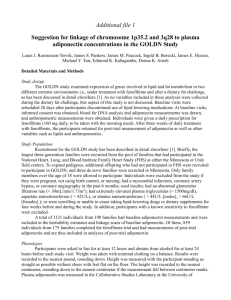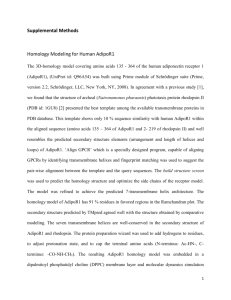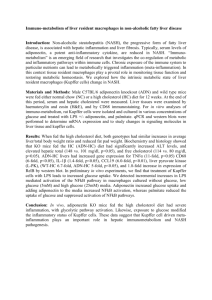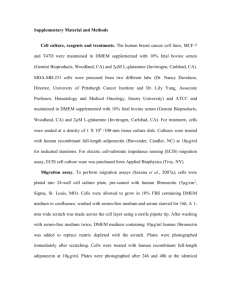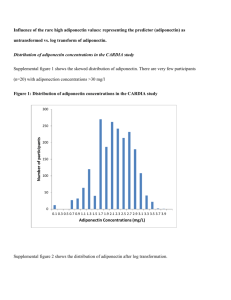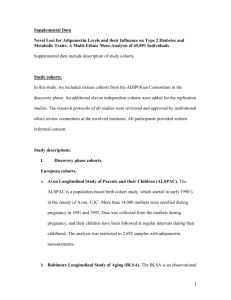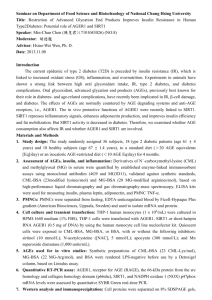Adiponectin: More Than Just Another Fat Cell Hormone?
advertisement
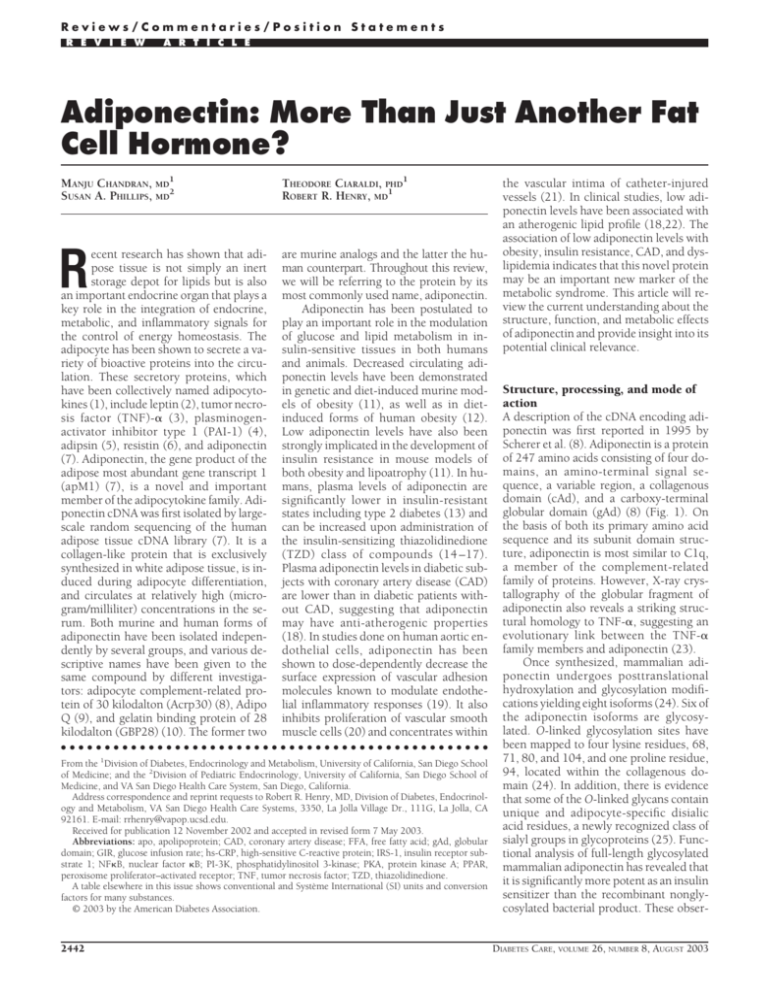
Reviews/Commentaries/Position Statements R E V I E W A R T I C L E Adiponectin: More Than Just Another Fat Cell Hormone? MANJU CHANDRAN, MD1 SUSAN A. PHILLIPS, MD2 THEODORE CIARALDI, PHD1 ROBERT R. HENRY, MD1 R are murine analogs and the latter the human counterpart. Throughout this review, we will be referring to the protein by its most commonly used name, adiponectin. Adiponectin has been postulated to play an important role in the modulation of glucose and lipid metabolism in insulin-sensitive tissues in both humans and animals. Decreased circulating adiponectin levels have been demonstrated in genetic and diet-induced murine models of obesity (11), as well as in dietinduced forms of human obesity (12). Low adiponectin levels have also been strongly implicated in the development of insulin resistance in mouse models of both obesity and lipoatrophy (11). In humans, plasma levels of adiponectin are significantly lower in insulin-resistant states including type 2 diabetes (13) and can be increased upon administration of the insulin-sensitizing thiazolidinedione (TZD) class of compounds (14 –17). Plasma adiponectin levels in diabetic subjects with coronary artery disease (CAD) are lower than in diabetic patients without CAD, suggesting that adiponectin may have anti-atherogenic properties (18). In studies done on human aortic endothelial cells, adiponectin has been shown to dose-dependently decrease the surface expression of vascular adhesion molecules known to modulate endothelial inflammatory responses (19). It also inhibits proliferation of vascular smooth muscle cells (20) and concentrates within ecent research has shown that adipose tissue is not simply an inert storage depot for lipids but is also an important endocrine organ that plays a key role in the integration of endocrine, metabolic, and inflammatory signals for the control of energy homeostasis. The adipocyte has been shown to secrete a variety of bioactive proteins into the circulation. These secretory proteins, which have been collectively named adipocytokines (1), include leptin (2), tumor necrosis factor (TNF)-␣ (3), plasminogenactivator inhibitor type 1 (PAI-1) (4), adipsin (5), resistin (6), and adiponectin (7). Adiponectin, the gene product of the adipose most abundant gene transcript 1 (apM1) (7), is a novel and important member of the adipocytokine family. Adiponectin cDNA was first isolated by largescale random sequencing of the human adipose tissue cDNA library (7). It is a collagen-like protein that is exclusively synthesized in white adipose tissue, is induced during adipocyte differentiation, and circulates at relatively high (microgram/milliliter) concentrations in the serum. Both murine and human forms of adiponectin have been isolated independently by several groups, and various descriptive names have been given to the same compound by different investigators: adipocyte complement-related protein of 30 kilodalton (Acrp30) (8), Adipo Q (9), and gelatin binding protein of 28 kilodalton (GBP28) (10). The former two ● ● ● ● ● ● ● ● ● ● ● ● ● ● ● ● ● ● ● ● ● ● ● ● ● ● ● ● ● ● ● ● ● ● ● ● ● ● ● ● ● ● ● ● ● ● ● ● ● From the 1Division of Diabetes, Endocrinology and Metabolism, University of California, San Diego School of Medicine; and the 2Division of Pediatric Endocrinology, University of California, San Diego School of Medicine, and VA San Diego Health Care System, San Diego, California. Address correspondence and reprint requests to Robert R. Henry, MD, Division of Diabetes, Endocrinology and Metabolism, VA San Diego Health Care Systems, 3350, La Jolla Village Dr., 111G, La Jolla, CA 92161. E-mail: rrhenry@vapop.ucsd.edu. Received for publication 12 November 2002 and accepted in revised form 7 May 2003. Abbreviations: apo, apolipoprotein; CAD, coronary artery disease; FFA, free fatty acid; gAd, globular domain; GIR, glucose infusion rate; hs-CRP, high-sensitive C-reactive protein; IRS-1, insulin receptor substrate 1; NFB, nuclear factor B; PI-3K, phosphatidylinositol 3-kinase; PKA, protein kinase A; PPAR, peroxisome proliferator–activated receptor; TNF, tumor necrosis factor; TZD, thiazolidinedione. A table elsewhere in this issue shows conventional and Système International (SI) units and conversion factors for many substances. © 2003 by the American Diabetes Association. 2442 the vascular intima of catheter-injured vessels (21). In clinical studies, low adiponectin levels have been associated with an atherogenic lipid profile (18,22). The association of low adiponectin levels with obesity, insulin resistance, CAD, and dyslipidemia indicates that this novel protein may be an important new marker of the metabolic syndrome. This article will review the current understanding about the structure, function, and metabolic effects of adiponectin and provide insight into its potential clinical relevance. Structure, processing, and mode of action A description of the cDNA encoding adiponectin was first reported in 1995 by Scherer et al. (8). Adiponectin is a protein of 247 amino acids consisting of four domains, an amino-terminal signal sequence, a variable region, a collagenous domain (cAd), and a carboxy-terminal globular domain (gAd) (8) (Fig. 1). On the basis of both its primary amino acid sequence and its subunit domain structure, adiponectin is most similar to C1q, a member of the complement-related family of proteins. However, X-ray crystallography of the globular fragment of adiponectin also reveals a striking structural homology to TNF-␣, suggesting an evolutionary link between the TNF-␣ family members and adiponectin (23). Once synthesized, mammalian adiponectin undergoes posttranslational hydroxylation and glycosylation modifications yielding eight isoforms (24). Six of the adiponectin isoforms are glycosylated. O-linked glycosylation sites have been mapped to four lysine residues, 68, 71, 80, and 104, and one proline residue, 94, located within the collagenous domain (24). In addition, there is evidence that some of the O-linked glycans contain unique and adipocyte-specific disialic acid residues, a newly recognized class of sialyl groups in glycoproteins (25). Functional analysis of full-length glycosylated mammalian adiponectin has revealed that it is significantly more potent as an insulin sensitizer than the recombinant nonglycosylated bacterial product. These obserDIABETES CARE, VOLUME 26, NUMBER 8, AUGUST 2003 Chandran and Associates Figure 1—The domain structure of Acrp30: signal sequence, species-specific variable region, collagenous domain, and globular trimerization domain. Modified with permission from Berg et al. (23). vations suggest that posttranslational modifications of adiponectin may be necessary for optimal biological activity. The basic building block of adiponectin is a tightly associated trimer, which is formed by association between three monomers at the globular domains. Monomeric (30-kDa) adiponectin has not been observed in the circulation and appears to be confined to the adipocyte. Four to six trimers associate through their collagenous domains to form higherorder structures, or oligomers, which circulate in plasma at concentrations of 5–30 g/ml (8,12,23) (Fig. 2). Without the collagenous domain, the globular domain of adiponectin still trimerizes but does not associate into higher-order structures (23). Although the precise molecular mechanisms underlying the tight association of adiponectin trimers are not known, it is likely that interactions involving both the globular and the collagenous domains are important for ensuring the stability and activity of the multimeric forms. The current methods available for measuring adiponectin in plasma include a radioimmunoassay (Linco, St Charles, MO) that measures the multimeric form and an enzyme-linked immunosorbent assay (B-Bridge International, San Jose, CA) that recognizes the denatured monoDIABETES CARE, VOLUME 26, NUMBER 8, AUGUST 2003 mer form. Circulating levels detected with either method appear to be similar. The pharmacological effects of adiponectin have been studied at animal, tissue, and cellular levels using a variety of recombinant adiponectin products. Studies investigating the bioactivity of full- length adiponectin versus that of the globular domain alone have produced mixed results. The globular head domain of adiponectin has been shown to be more potent than the full-length form in ameliorating hyperglycemia and hyperinsulinemia in diet-induced and genetic forms of murine obesity (11) and in decreasing elevated plasma free fatty acids in mice fed a high-fat meal or given intravenous intralipid injections (26). These results are in contrast to those of Berg et al. (27), whereby injection of bacterially produced globular adiponectin into mouse models of type 1 and 2 diabetes did not induce a decrease in serum glucose, although the full-length form did. It is possible that adiponectin exists as variable protein complexes that exert different effects in various tissues. The mechanisms through which adiponectin exerts its actions are largely unknown and controversial. Adiponectin administration to rodents has been shown to increase insulin-induced tyrosine phosphorylation of the insulin receptor in skeletal muscle in association with increased whole-body insulin sensitivity (11). These results were also validated in a recent study conducted in humans (28). Stimulation of glucose utilization and fatty acid oxidation in skeletal muscle and liver by adiponectin may also occur through activation of 5⬘-AMP kinase. 5⬘- Figure 2— Model for assembly of adiponectin complexes. Three monomers form a trimer through associations between their globular domains. Four to six trimers associate noncovalently through their collagenous domains to form high–molecular-weight oligomers, which circulate in the plasma. Modified with permission from Berg et al. (23). 2443 Adiponectin Figure 3— Hypothetical model for the actions of adiponectin. In skeletal muscle, adiponectin increases tyrosine phosphorylation of the insulin receptor. This effect may contribute to increased insulin sensitivity. It also increases fatty acid oxidation, probably by activation of 5⬘-AMP kinase, with resultant decreased intramyocellular steatosis. In the liver, the decreased free fatty acid influx and increased fatty acid oxidation contribute to reduced hepatic glucose output and VLDL triglyceride synthesis. In vascular endothelium, adiponectin decreases monocyte adhesion to endothelium, suppresses macrophage–to–foam cell transformation, and inhibits vascular smooth muscle cell proliferation and migration. AMP–activated protein kinase is believed to play a crucial role in the regulation of energy expenditure and glucose and lipid metabolism. The tissue-specific effect of adiponectin on 5⬘-AMP kinase has recently been demonstrated in mice. In these studies, both the globular and fulllength forms of adiponectin activated 5⬘AMP kinase in skeletal muscle, but only the full-length form stimulated phosphorylation and activation of AMP kinase in the liver (29). In skeletal muscle of mice, adiponectin has been shown to increase expression of the genes encoding proteins involved in fatty acid transport and oxidation, such as CD36, acyl-CoA oxidase, and uncoupling protein, resulting in enhanced fat combustion and energy dissipation (11). In the liver, low doses of adiponectin decreased the expression of proteins involved in fatty acid transport, such as CD36, leading to reduced fatty acid influx into the liver and hepatic triglyceride content (11). Improved hepatic insulin sensitivity occurred, leading the investigators to postulate that the primary effects of 2444 adiponectin on muscle are to augment uptake and combustion of free fatty acids (FFAs), whereas decreased liver triglyceride content results from secondary reductions in serum FFA and triglyceride levels. In a separate experiment by the same group (30), amelioration of insulin resistance, -cell degranulation, and diabetes occurred in globular adiponectin transgenic (gAd Tg) crossed with leptindeficient ob/ob mice. Again, these findings were associated with increased skeletal muscle fatty acid oxidation. This finding is in contrast to that reported by another group in which, in the basal state, adiponectin exerted an insulin-sensitizing effect on hepatocytes with suppression of hepatic glucose output without a sustained attenuation of triglyceride accumulation in this tissue (27). A unified theme for the method and site of adiponectin action thus remains to be determined (Fig. 3). Epidemiology Although adiponectin is secreted only from adipose tissue, its levels are paradox- ically lower in obese than in lean humans (12). This is in contrast to most other adipocytokines, whose levels are increased in obesity in proportion to an increased total body fat mass. It is possible that although adiponectin expression is activated during adipogenesis, a feedback inhibition on its production may occur during the development of obesity. For example, adipocyte expression and secretion of adiponectin has been shown to be reduced by TNF-␣ (31). Therefore it may be reasonable to surmise that increased TNF-␣ and possibly other adipocytokines that are expressed in increased amounts in the obese state may at least be partially responsible for the decreased adiponectin production in obesity. Levels are also lower in patients with essential hypertension (32) and in diabetic patients compared with nondiabetic subjects (18), and are particularly low in subjects with CAD (18). Decreased levels are found in men compared with women (12), and this may be androgen induced (33). The incidence of cardiovascular death has been found to be higher in patients with renal failure who have decreased adiponectin levels (hypoadiponectinemia) (34). Decreased adiponectin levels were found to be closely related to the degree of insulin resistance and hyperinsulinemia in a study conducted on Pima Indians and Caucasians— individuals with a wide range of glucose tolerance (13). Ethnicity seems to play a role, since one study showed significantly higher plasma concentrations of adiponectin in Caucasians compared with BMI-matched Indo-Asians (35). Hotta et al. (18) have reported a significant negative correlation between circulating adiponectin and triglyceride levels and a positive correlation between adiponectin and HDL cholesterol levels in type 2 diabetes. Matsubara et al. (22) demonstrated that plasma adiponectin concentrations were not only inversely related to triglyceride levels, atherogenic index (total:HDL cholesterol), and apolipoproteins (apos) B and E, but also positively correlated to serum HDL cholesterol and apo A-1 in nondiabetic female patients. These declines in adiponectin in hypertriglyceridemic, high atherogenic index, and low HDL states were also observed after adjusting for BMI, body fat mass, age, and diastolic blood pressure. These findings suggest that the hypoadiponectinemia observed in dyslipidemia may accelerate DIABETES CARE, VOLUME 26, NUMBER 8, AUGUST 2003 Chandran and Associates the atherosclerotic changes seen in the metabolic syndrome. Metabolic roles of adiponectin Adiponectin as a mediator of insulin action/resistance A strong correlation between adiponectin and systemic insulin sensitivity has been well established both in vivo and in vitro in mice, other animals, and humans (11,17,27,36 – 42). In experiments conducted by Berg et al. (27), intraperitoneal injection of mammalian-expressed full-length adiponectin into fasting male wild-type mice and two models of type 1 diabetes—insulinopenic nonobese diabetic and streptozotocininduced diabetic mice—produced a significant transient reduction of glucose levels. Adiponectin did not appear to be acting primarily as an insulin secretagogue, since insulin levels were low at the beginning of the experiments in all animals and remained low even after adiponectin injection. Adiponectin injection into a type 2 diabetic model (ob/ob mice) also lowered glucose levels. Despite dramatically different insulin levels in the different mouse models, a common mechanism appeared to be responsible for the decreased plasma glucose sensitization of the liver to insulin-induced suppression of hepatic glucose output. Studies by Yamauchi et al. (11) showed similar effects, namely improved insulin sensitivity and amelioration of hyperglycemia in mouse models of obesity, diabetes, and lipoatrophy, although following systemic infusion of physiological doses of the globular domain of adiponectin, not the full-length form. Euglycemichyperinsulinemic clamp studies have shown that acutely increasing circulating adiponectin levels by infusion of recombinant full-length adiponectin improves insulin-induced suppression of hepatic glucose production in mice. This was associated with a reduced expression of the gluconeogenic enzymes PEPCK and glucose-6-phosphatase (G6Pase), indicating that transcriptional regulation of these two enzymes may contribute to the molecular mechanism of action of adiponectin (36). Circulating adiponectin levels have been shown to decrease in parallel with progression of insulin resistance during development of type 2 diabetes in rhesus monkeys genetically predisposed to deDIABETES CARE, VOLUME 26, NUMBER 8, AUGUST 2003 velop insulin resistance (37). In this study, there was a negative correlation of adiponectin levels with body weight and fasting insulin levels and a positive correlation with insulin-stimulated glucose uptake (a marker of insulin sensitivity). In these monkeys, the decline in adiponectin levels preceded overt hyperglycemia. Development of hyperinsulinemia is one possible mechanism for the suppression of adiponectin levels seen in these studies. However, hyperinsulinemia per se seems unlikely as a mediator of low adiponectin levels, since adiponectin levels remain low in the later stages of type 2 diabetes in association with decreased circulating insulin levels. Adipocyte insulin action or signal transduction rather than absolute levels of insulin may regulate adiponectin secretion. In support of this contention, Bogan and Lodish (43) have shown that secretion of adiponectin by 3T3-L1 adipocytes requires phosphatidylinositol 3-kinase (PI-3K), a major intermediate of insulin signaling activity. Insulinstimulated insulin receptor substrate 1 (IRS-1)-associated PI-3K activity has been shown to be decreased in adipocytes of type 2 diabetic subjects (44). Thus it is possible that the decreased adipocyte PI-3K activity in type 2 diabetic patients may contribute to the decreased adiponectin levels. Additional investigations to test this hypothesis are warranted. Other investigators have presented data on the potential inverse relationship between adiponectin and insulin action. Euglycemic-hyperinsulinemic clamp studies in both humans and rats (45) have shown that insulin infusion leads to decreased circulating adiponectin levels, consistent with the interpretation that insulin exerts an acute effect on adipocytes to decrease production and/or secretion of this adipocytokine. Fasshauer et al. (38) have published data supporting a possible role of adiponectin in catecholamine-induced insulin resistance. They found that treating 3T3-L1 adipocytes with the -adrenergic agonist isoproterenol reduced the level of adiponectin mRNA by ⬃75% in vitro. This inhibitory effect of isoproterenol was almost completely reversed by pretreatment of the cells with the -adrenergic antagonist propranolol and the protein kinase A (PKA) inhibitor H-89. The authors concluded that catecholamines might induce insulin resistance at least partly by downregulation of adiponectin gene expression, and that this inhibitory effect was mediated via -adrenergic receptors through a Gs protein (stimulatory guanine nucleotide binding)PKA– dependent pathway. Homozygous (adipo –/– ) adiponectin-deficient mice have been shown to have significantly increased insulin resistance when compared with wild-type and heterozygous (adipo⫹/–) adiponectin-deficient mice in studies conducted by Kubota et al. (39). This loss-of-function experiment provides further evidence that adiponectin is indeed required for normal regulation of insulin sensitivity and glucose homeostasis in vivo. The connection between adiponectin levels and insulin resistance has been further confirmed by data obtained from treatment with TZDs. The peroxisome proliferator–activated receptor (PPAR)-␥ is a ligand-activated transcription factor thought to be a master regulator of adipocyte differentiation and multiple adipocyte genes. TZDs are specific synthetic ligand activators of PPAR-␥ that improve glucose tolerance and insulin sensitivity in type 2 diabetic patients and in animal models of insulin resistance through mechanisms that are incompletely understood. The administration of TZDs has been shown to increase the plasma adiponectin concentrations in insulinresistant humans and rodents and in subjects with type 2 diabetes (14 –17). The promoter activity of the adiponectin gene has been shown to be markedly enhanced by the TZDs (14), although the presence of a functional PPAR-␥ response element in the adiponectin gene remains controversial (46,47). The induction of adiponectin in fact might be caused by secondary effects involving other PPARinducible genes and not by specific activation of the PPAR response elements (48). In support of an important role for PPAR-␥ in regulation of adiponectin synthesis, circulating adiponectin levels were found by Combs et al. (17) to be suppressed fivefold in patients with severe insulin resistance in association with dominant-negative PPAR-␥ mutations. Thus, induction of adipose tissue adiponectin expression and consequent increases in circulating adiponectin levels could potentially represent a novel potential mechanism for PPAR-␥–mediated enhancement of whole-body insulin sensitivity. Furthermore, adiponectin may be a biomarker of in vivo PPAR-␥ activation. 2445 Adiponectin Combs et al. reported an increase in adiponectin levels in normal subjects after only 14 days of treatment with rosiglitazone. This finding was supported by a recent study in rats, which showed a similar increase in adiponectin levels after 2 weeks of TZD treatment (37). In another study (16), an increase in the plasma adiponectin levels was observed along with weight gain after rosiglitazone treatment. These results may appear contradictory to the reported negative correlation between plasma adiponectin levels and body weight. The activation of PPAR-␥ by TZDs may promote weight gain by increasing adipocyte differentiation and the number of small adipocytes, as has been previously shown (49), as well as enhance adiponectin gene transcription in existing mature adipocytes, thus increasing adiponectin levels. Adiponectin has also been proposed by some investigators as a reliable marker for insulin resistance in type 2 diabetes. Tajiri et al. (40) used the hyperinsulinemic-euglycemic clamp to quantify glucose infusion rate (GIR) as an index for insulin sensitivity in 16 patients with type 2 diabetes. GIR was most strongly correlated with circulating adiponectin levels and fasting plasma glucose. The role of adiponectin in mitigating insulin resistance has been further substantiated by studies in humans and mice with lipodystrophies (11,41,42). Lipodystrophies are characterized by selective but variable loss of body fat and insulin resistance. Serum adiponectin levels are extremely low in patients with generalized lipodystrophies and may be related to the general absence of adipose tissue and/or associated severe insulin resistance. Yamauchi et al. (11) showed that treating lipoatrophic mice with physiological doses of adiponectin significantly but not completely ameliorated hyperglycemia and hyperinsulinemia. Adipose tissue expression and circulating adiponectin concentrations have also been found to be significantly decreased in HIV-positive patients with lipodystrophy treated with highly active antiretroviral therapy. Both serum and mRNA concentrations of adiponectin were found to closely correlate with features of insulin resistance, including hepatic fat content (50). Thus, it may be reasonable to surmise that decreased production of adiponectin in lipoatrophic adipose tissue 2446 may contribute to the development of insulin resistance in these patients. Although a cause-and-effect association has not been definitely established, available evidence indicates that visceral fat is an important link between the many facets of the metabolic syndrome, including glucose intolerance, hypertension, dyslipidemia, and insulin resistance (51). Visceral adiposity is characterized by enhanced lipolysis (1) and augmented plasma FFA flux, especially into the portal circulation. Increased inflow of FFAs into the liver from the portal circulation is thought to retard insulin clearance and to enhance lipid synthesis, which may result in peripheral hyperinsulinemia and hyperlipidemia. FFAs have also been shown to induce hepatic insulin resistance by inhibiting insulin suppression of glycogenolysis during euglycemichyperinsulinemic clamp studies (52) and to directly stimulate glycogenolysis and gluconeogenesis, thus contributing to mild fasting hyperglycemia in euglycemic subjects given lipid infusions (53). Adiponectin mRNA and protein levels have been found to be reduced in omental fat compared with subcutaneous fat (54). Visceral fat may also produce an as-yet-unidentified factor that destabilizes adiponectin mRNA (55). The strong inverse correlation between serum adiponectin levels and intra-abdominal fat mass may in part underlie the link between visceral fat and insulin resistance. Although these epidemiological and experimental studies are suggestive of a role for adiponectin in insulin sensitivity and firmly establish an association between insulin resistance and low plasma adiponectin levels, it is not yet established whether decreased adiponectin levels are the cause or effect of this dysregulated metabolic state. Adiponectin and atherosclerosis Experimental studies have indicated that adiponectin has potential antiatherogenic and anti-inflammatory properties (19 – 21,56 – 60). Monocyte adhesion to the vascular endothelium and subsequent differentiation to macrophages and foam cells is considered crucial for the development of vascular disease. Ouchi et al. (19) found that adiponectin had effects on monocyte adhesion to endothelium, myeloid differentiation, and macrophage cytokine production and phagocytosis. Adiponectin has been shown to inhibit both the production and action of TNF-␣, a cytokine that has direct effects on the adhesion molecules (3,19). Although its receptor has not been identified, adiponectin modulates signaling of nuclear factor B (NFB) (a transcription factor involved in the inflammatory response), at least partly through a cAMP-dependent pathway (56). Ouchi et al. (57) also showed that adiponectin suppressed macrophage–to–foam cell transformation in vitro. Thus adiponectin probably serves as a modulator for macrophage foam cell formation and could provide an answer to the fundamental mechanism for the link between vascular inflammation and atherosclerosis. Furthermore, adiponectinmediated signaling has been shown to inhibit growth factor–induced human aortic smooth muscle cell proliferation and migration (20). These in vitro studies demonstrate that adiponectin may act as an antiatherosclerotic factor through a direct effect on endothelial cells. Severe neointimal thickening and increased proliferation of vascular smooth muscle cells has been demonstrated in mechanically injured arteries of adiponectin knockout mice. Supplementation of adiponectin in this mouse model attenuated the neointimal proliferation (58). This has been the first in vivo evidence that adiponectin might serve as a critical link bridging the adipose tissue–vascular axis. Amelioration of atherosclerosis associated with decreased expresson of class A scavenger receptor and TNF-␣ has been demonstrated in globular adiponectin transgenic (gAd Tg) apo E– deficient mice (30). This appears to be the first in vivo demonstration of a protective role of adiponectin against atherosclerosis. High-sensitive C-reactive protein (hsCRP) is a well-known marker and risk factor for coronary artery disease. It was recently shown that CRP mRNA is expressed in human adipose tissue (59). A significant inverse correlation has been observed between CRP and adiponectin mRNA levels in subcutaneous adipose tissue of human subjects with angiographically demonstrated coronary atherosclerosis (59). The same negative correlation exists between plasma hs-CRP and adiponectin levels. This reciprocal association between adiponectin and CRP levels in both human adipose tissue and plasma is supportive of a role for adiponectin against the development of atherosclerosis and vascular inflammation. DIABETES CARE, VOLUME 26, NUMBER 8, AUGUST 2003 Chandran and Associates Clinical relevance of adiponectin Type 2 diabetes results from an interaction between genetic and environmental factors. Genome-wide scans have mapped a susceptibility locus for type 2 diabetes, metabolic syndrome, and coronary heart disease to chromosome 3q27, where the gene encoding adiponectin is located (60 – 63). Hara et al. (64) found that genetic variations resulting in reduced serum adiponectin levels are associated with increased risk for type 2 diabetes in the Japanese population. In another study, Japanese subjects carrying a missense mutation in the adiponectin gene associated with hypoadiponectinemia exhibited the phenotype of the metabolic syndrome, including insulin resistance and coronary artery disease (65). Thus genetic polymorphisms of the adiponectin gene that result in lower production and secretion of adiponectin may be responsible, at least in part, for the pathogenesis of the insulin resistance syndrome and diabetes. Conversely, increased baseline concentrations of adiponectin may be associated with a reduced risk of developing type 2 diabetes (66). Replenishment of adiponectin might represent a novel treatment strategy for insulin resistance and type 2 diabetes. Adiponectin might have several therapeutic advantages over antidiabetic drugs now used clinically. First, in addition to hypolipidemic and antidiabetic effects, adiponectin has potential anti-inflammatory properties that might prevent or retard atherogenesis. Second, adiponectin appears to exert these effects without increasing body weight (11). Adiponectin might have therapeutic implications as an anti-obesity drug as well, although there have been no studies in humans so far. In the study by Yamauchi et al. (11), administration of adiponectin slightly but not significantly reduced weight gain induced by a high-fat diet in mice. In studies by Fruebis et al. (26), daily administration of a very low dose of gAd to mice consuming a high-fat/ sucrose diet caused profound and sustainable weight reduction without affecting food intake. The effect of gAd on weight reduction may reflect its ability to stimulate lipid oxidation or some other yet-to-be-described mechanism. It remains to be determined whether adiponectin can be effectively and safely used as a pharmacologic means to treat obesity in humans. It is also important to DIABETES CARE, VOLUME 26, NUMBER 8, AUGUST 2003 note that although low concentrations of plasma adiponectin are observed in obese individuals, a prospective study done in Pima Indians found that circulating adiponectin levels did not predict future weight gain and thus did not appear to play an etiologic role in the development of obesity in these individuals (67). Improvement in insulin sensitivity by weight reduction in obese subjects with gastric bypass surgery (68,69) has been reported to increase adiponectin levels. However there has been conflicting data on whether improvement in insulin sensitivity with exercise training is associated with increased adiponectin levels. One study found a correlation between incremental increases in glucose infusion rates (a measure of insulin sensitivity) during euglycemic-hyperinsulinemic clamp studies and adiponectin levels with intensive aerobic exercise (70), whereas another group of investigators found no increase in adiponectin levels even after 6 months of exercise training, although insulin action significantly improved (71). The differences in these observations may be in part due to the fact that there was improvement in body composition with the first study, whereas there was no loss of body mass in the latter. In view of its potential beneficial effects, any measure that increases adiponectin levels would likely have some clinical significance. Whether this improvement in insulin sensitivity by the above measures or by treatment with PPAR gamma agonists is mediated entirely or in part by adiponectin has yet to be determined. CONCLUSION — The view of the adipocyte as simply a storage depot for fat is no longer tenable. Among the various “adipocytokines,” adiponectin, which is an abundant circulating protein synthesized solely in adipose tissue, appears to play a very important role in carbohydrate and lipid metabolism and vascular biology. Adiponectin appears to be a major modulator of insulin action and its levels are reduced in type 2 diabetes, which could contribute to peripheral insulin resistance in this condition. It has significant insulin-sensitizing as well as antiinflammatory properties that include suppression of macrophage phagocytosis and TNF-␣ secretion and blockage of monocyte adhesion to endothelial cells in vitro. To date, however, adiponectin’s putative antiatherogenic potential in hu- mans remains substantially weaker and less well studied than its insulinsensitizing effects. Although further investigations are required, adiponectin administration, as well as regulation of the pathways controlling its production, represents a promising target for managing obesity, hyperlipidemia, insulin resistance, type 2 diabetes, and vascular inflammation. Numerous important questions about adiponectin await further study. The mechanisms by which adiponectin is synthesized and secreted need to be elucidated, as do the signals that reduce adiponectin expression in adipocytes with increasing adiposity. Similarly, the role and regulation of adiponectin oligomerization need to be defined. The molecular mechanisms by which adiponectin exerts its multiple functions and whether its actions are receptor mediated still remain a mystery. Is the primary activity of adiponectin antiatherosclerotic, or is it principally a modulator of lipid metabolism and regulator of insulin sensitivity— or is it all of the above? The answers to these and other intriguing questions will undoubtedly provide additional insight into the metabolic roles of this new adipocyte hormone. ACKNOWLEDGMENTS — T h i s work was supported by grants from the Medical Research Service, Department of Veterans Affairs, and VA San Diego Healthcare System, American Diabetes Association (T.C.), National Institutes of Health (NIH) Grants KO8DK-61987 (S.A.P.) and RO1DK-58291 (R.R.H.), and Grant MO1RR-00827 from the General Clinical Research Branch, Division of Research Resources, NIH. We thank Ryan R. Henry and Murali Chandrah for their valuable help with the figures. References 1. Matsuzawa Y, Funahashi T, Nakamura T: Molecular mechanism of metabolic syndrome X: contribution of adipocytokines, adipocyte-derived bioactive substances. Ann N Y Acad Sci 892:146 –154, 1999 2. Friedman JM: Obesity in the new millennium. Nature 404:632– 634, 2000 3. Hotamisligil GS: The role of TNF-␣ and TNG receptors in obesity and insulin resistance. J Intern Med 245:621– 625, 1999 4. Shimomura I, Funahashi T, Takahashi M, Maeda K, Kotani K, Nakamura T, Ya- 2447 Adiponectin 5. 6. 7. 8. 9. 10. 11. 12. 13. 14. mashita S, Miura M, Fukuda Y, Takemura K, Tokunaga K, Matsuzawa Y: Enhanced expression of PAI-1 in visceral fat: possible contributor to vascular disease in obesity. Nat Med 2:800 – 803, 1996 White RT, Damm D, Hancock N, Rosen BS, Lowell BB, Usher P, Flier JS, Spiegelman BM: Human adipsin is identical to complement factor D and is expressed in high levels in adipose tissue. J Biol Chem 267:9210 –9213, 1992 Steppan CM, Bailey ST, Bhat S, Brown EJ, Banerjee RR, Wright CM, Patel HR, Ahima RS, Lazar MA: The hormone resistin links obesity to diabetes. Nature 409: 307–312, 2001 Maeda K, Okubo K, Shimomura I, Funahashi T, Matsuzawa Y, Matsubara K: cDNA cloning and expression of a novel adipose specific collagen-like factor, apM1 (adipose most abundant gene transcript 1). Biochem Biophys Res Commun 221:286 –289, 1996 Scherer PE, Williams S, Fogliano M, Baldini G, Lodish HF: A novel serum protein similar to C1q produced exclusively in adipocytes. J Biol Chem 270:26746 –26749, 1995 Hu E, Liang P, Spiegelman BM: AdipoQ is a novel adipose-specific gene dysregulated in obesity. J Biol Chem 271:10697– 10703, 1996 Nakano Y, Tobe T, Choi-Miura NH, Mazda T, Tomita M: Isolation and characterization of GBP28, a novel gelatin-binding protein purified from human plasma. J Biochem 120:803– 812, 1996 Yamauchi T, Kamon J, Waki H, Terauchi Y, Kubota N, Hara K, Mori Y, Ide T, Murakami K, Tsuboyama-Kasaoka N, Ezaki O, Akanuma Y, Gavrilova O, Vinson C, Reitman ML, Kagechika H, Shudo K, Yoda M, Nakano Y, Tobe K, Nagai R, Kimura S, Tomita M, Froguel P, Kadowaki T: The fat derived hormone adiponectin reverses insulin resistance associated with both lipoatrophy and obesity. Nat Med 7:941–946, 2001 Arita Y, Kihara S, Ouchi N, Takahashi M, Maeda K, Miyagawa J, Hotta K, Shimomura I, Nakamura T, Miyaoka K, Kuriyama H, Nishida M, Yamashita S, Okubo K, Matsubara K, Muraguchi M, Ohmoto Y, Funahashi T, Matsuzawa Y: Paradoxical decrease of an adipose-specific protein, adiponectin, in obesity. Biochem Biophys Res Commun 257:79 – 83, 1999 Weyer C, Funahashi T, Tanaka S, Hotta K, Matsuzawa Y, Pratley RE, Tataranni PA: Hypoadiponectimia in obesity and type 2 diabetes: close association with insulin resistance and hyperinsulinemia. J Clin Endocrinol Metab 86:1930 –1935, 2001 Maeda N, Takahashi M, Funahashi T, 2448 15. 16. 17. 18. 19. 20. 21. Kihara S, Nishizawa H, Kishida K, Nagaretani H, Matsuda M, Komuro R, Ouchi N, Kuriyama H, Hotta K, Nakamura T, Shimomura I, Matsuzawa Y: PPAR gamma ligands increase expression and plasma concentrations of adiponectin an adipose derived protein. Diabetes 50:2094 –2099, 2001 Hirose H, Kawai T, Yamamoto Y, Taniyama M, Tomita M, Matsubara K, Okazaki Y, Ishii T, Oguma Y, Takei I, Saruta T: Effects of pioglitazone on metabolic parameters, body fat distribution and serum adiponectin levels in Japanese male patients with type 2 diabetes. Metabolism 51:314 –317, 2002 Yang WS, Jeng CY, Wu TJ, Tanaka S, Funahashi T, Matsuzawa Y, Wang JP, Chen CL, Tai TY, Chuang LM: Synthetic peroxisome proliferator-activated receptorgamma agonist, rosiglitazone, increases plasma levels of adiponectin in type 2 diabetic patients. Diabetes Care 25:376 – 380, 2002 Combs TP, Wagner JA, Berger J, Doebber T, Wang WJ, Zhang BB, Tanen M, Berg AH, O’Rahilly S, Savage DB, Chatterjee K, Weiss S, Larson PJ, Gottesdiener KM, Gertz BJ, Charron MJ, Scherer PE, Moller DE: Induction of adipocyte complement related protein of 30 kilodaltons by PPARgamma agonists: a potential mechanism of insulin sensitization. Endocrinology 143:998 –1007, 2002 Hotta K, Funahashi T, Arita Y, Takahashi M, Matsuda M, Okamoto Y, Iwahashi H, Kuriyama H, Ouchi N, Maeda K, Nishida M, Kihara S, Sakai N, Nakajima T, Hasegawa K, Muraguchi M, Ohmoto Y, Nakamura T, Yamashita S, Hanafusa T, Matsuzawa Y: Plasma concentration of a novel adipose specific protein adiponectin in type 2 diabetic patients. Arterioscler Thromb Vasc Biol 20:1595–1599, 2000 Ouchi N, Kihara S, Arita Y, Maeda K, Kuriyama H, Okamoto Y, Hotta K, Nishida M, Takahashi M, Nakamura T, Yamashita S, Funahashi T, Matsuzawa Y: Novel modulator for endothelial adhesion molecules: adipocyte-derived plasma protein adiponectin. Circulation 100: 2473–2476, 1999 Arita Y, Kihara S, Ouchi N, Maeda K, Kuriyama H, Okamoto Y, Kumada M, Hotta K, Nishida M, Takahashi M, Nakamura T, Shimomura I, Muraguchi M, Ohmoto Y, Funahashi T, Matsuzawa Y: Adipocyte-derived plasma protein adiponectin acts as a platelet-derived growth factor-BB-binding protein and regulates growth factor-induced common post receptor signal in vascular smooth muscle cell. Circulation 18:105:2893–2898, 2002 Okamoto Y, Arita Y, Nishida M: An adipocyte-derived plasma protein, adiponectin, adheres to injured vascular walls. Horm Metab Res 32:47–50, 2000 22. Matsubara M, Maruoka S, Katayose S: Decreased plasma adiponectin concentrations in women with dyslipidemia. J Clin Endocrinol Metab 87:2764 –2769, 2002 23. Berg AH, Combs TP, Scherer PE: Acrp30/ adiponectin: an adipocytokine regulating glucose and lipid metabolism. Trends Endocrinol Metabolism 13:84 – 89, 2002 24. Wang Y, Xu A, Knight C, Xu LY, Cooper GJ: Hydroxylation and glycosylation of the four conserved lysine residues in the collagenous domain of adiponectin: potential role in the modulation of its insulin-sensitizing activity. J Biol Chem 277: 19521–19529, 2002 25. Sato C, Yasukawa Z, Honda N, Matsuda T, Kitajima K: Identification and adipocyte differentiation-dependent expression of the unique disialic acid residue in an adipose tissue-specific glycoprotein, adipoQ. J Biol Chem 276:28849 –28856, 2001 26. Fruebis J, Tsao TS, Javorschi S, EbbetsReed D, Erickson MR, Yen FT, Bihain BE, Lodish HF: Proteolytic cleavage product of 30-kDa adipocyte complement related protein increases fatty acid oxidation in muscle and causes weight loss in mice. Proc Natl Acad Sci U S A 98:2005–2010, 2001 27. Berg AH, Combs TP, Du X, Brownlee M, Scherer PE: The adipocyte-secreted protein Acrp30 enhances hepatic insulin action. Nat Med 7:947–953, 2001 28. Stefan N, Vozarova B, Funahashi T, Matsuzawa Y, Weyer C, Lindsay RS, Youngren JF, Havel PJ, Pratley RE, Bogardus C, Tataranni PA: Plasma adiponectin concentration is associated with skeletal muscle insulin receptor tyrosine phosphorylation and low plasma concentration precedes a decrease in whole-body insulin sensitivity in humans. Diabetes 51: 1884 –1888, 2002 29. Yamauchi T, Kamon J, Minokoshi Y, Ito Y, Waki H, Uchida S, Yamashita S, Noda M, Kita S, Ueki K, Eto K, Akanuma Y, Froguel P, Foufelle F, Ferre P, Carling D, Kimura S, Nagai R, Kahn BB, Kadowaki T: Adiponectin stimulates glucose utilization and fatty acid oxidation by activating AMP-activated protein kinase. Nat Med 8:1288 –1295, 2002 30. Yamauchi T, Kamon J, Waki H, Imai Y, Shimozawa N, Hioki K, Uchida S, Ito Y, Takakuwa K, Matsui J, Takata M, Eto K, Terauchi Y, Komeda K, Tsunoda M, Murakami K, Ohnishi Y, Naitoh T, Yamamura K, Ueyama Y, Froguel P, Kimura S, Nagai R, Kadowaki T: Globular adiponectin protected ob/ob mice from diabetes and ApoE-deficient mice from atherosclerosis. J Biol Chem 278:2461–2468, 2003 31. Kappes A, Loffler G: Influences of iono- DIABETES CARE, VOLUME 26, NUMBER 8, AUGUST 2003 Chandran and Associates 32. 33. 34. 35. 36. 37. 38. 39. 40. mycin, dibutyryl-cycloAMP and tumor necrosis factor alpha on intracellular amount and secretion of apM1 in differentiating primary human preadipocytes. Hormone Metab Res 32:548 –554, 2000 Adamczak M, Wiecek A, Funahashi T, Chudek J, Kokot F, Matsuzawa Y: Decreased plasma adiponectin concentration in patients with essential hypertension. Am J Hypertens 16:72–75, 2003 Nishizawa H, Shimomura I, Kishida K, Maeda N, Kuriyama H, Nagaretani H, Matsuda M, Kondo H, Furuyama N, Kihara S, Nakamura T, Tochino Y, Funahashi T, Matsuzawa Y: Androgens decrease plasma adiponectin, an insulinsensitizing adipocyte-derived protein. Diabetes 51:2734 –2741, 2002 Zoccali C, Mallamaci F, Tripepi G, Benedetto FA, Cutrupi S, Parlongo S, Malatino LS, Bonanno G, Seminara G, Rapisarda F, Fatuzzo P, Buemi M, Nicocia G, Tanaka S, Ouchi N, Kihara S, Funahashi T, Matsuzawa Y: Adiponectin, metabolic risk factors, and cardiovascular events among patients with end-stage renal disease. J Am Soc Nephrol 13:134 – 141, 2002 Valsamakis G, Chetty R, McTernan PG, Al-Daghri NM, Barnett AH, Kumar S: Fasting serum adiponectin concentration is reduced in Indo-Asian subjects and is related to HDL cholesterol. Diabetes Obes Metab 5:131–135, 2003 Combs TP, Berg AH, Obici S, Scherer PE, Rossetti L: Endogenous glucose production is inhibited by the adipose-derived protein Acrp30. J Clin Invest 108:1875– 1881, 2001 Hotta K, Funahashi T, Bodkin NL, Ortmeyer HK, Arita Y, Hansen BC, Matsuzawa Y: Circulating concentrations of the adipocyte protein adiponectin are decreased in parallel with reduced insulin sensitivity during the progression to type 2 diabetes in rhesus monkeys. Diabetes 50:1126 –1133, 2001 Fasshauer M, Klein J, Neumann S, Eszlinger M, Paschke R: Adiponectin gene expression is inhibited by beta adrenergic stimulation via protein kinase A in 3T3– L1 adipocytes. FEBS Lett 507:142–146, 2001 Kubota N, Terauchi Y, Yamauchi T, Kubota T, Moroi M, Matsui J, Eto K, Yamashita T, Kamon J, Satoh H, Yano W, Froguel P, Nagai R, Kimura S, Kadowaki T, Noda T: Disruption of adiponectin causes insulin resistance and neointimal formation. J Biol Chem 277:25863–25866, 2002 Tajiri Y, Hiramatsu S, Karashima T, Mimura K, Umeda F: Adiponectin as a reliable marker for insulin resistance in type 2 diabetic patients (Abstract). Diabetes 51 (Suppl. 2):A305, 2002 DIABETES CARE, VOLUME 26, NUMBER 8, AUGUST 2003 41. Matsubara M, Maruoka S, Katayose S: Inverse relationship between plasma adiponectin and leptin concentrations in normal weight and obese women. Eur J Endocrinol 147:173–180, 2002 42. Haque WA, Shimomura I, Matsuzawa Y, Garg A: Serum adiponectin and leptin levels in patients with lipodystrophies. J Clin Endocrinol Metab 87:2395–2398, 2002 43. Bogan JS, Lodish HF: Two compartments for insulin-stimulated exocytosis in 3T3– L1 adipocytes defined by endogenous ACRP30 and GLUT4. J Cell Biol 146: 609 –620, 1999 44. Smith U, Axelsen M, Carvalho E, Eliasson B, Jansson PA, Wesslau C: Insulin signaling and action in fat cells: associations with insulin resistance and type 2 diabetes. Ann N Y Acad Sci 892:119 –126, 1999 45. Yu JG, Javorschi S, Hevener AL, Kruszynska YT, Norman RA, Sinha M, Olefsky JM: The effect of thiazolidinediones on plasma adiponectin levels in normal, obese and type 2 diabetic subjects. Diabetes 51:2968 –2974, 2002 46. Das K, Lin Y, Widen E, Zhang Y, Scherer PE: Chromosomal localization, expression pattern and promoter analysis of the mouse gene encoding adipocytespecific secretory protein Acrp30. Biochem Biophys Res Commun 280:1120 – 1129, 2001 47. Schaffler A, Orso E, Palitzsch KD, Buchler C, Drobnik W, Furst A, Scholmerich J, Schmitz G: The human apM-1, an adipocyte-specific gene linked to the family of TNFs and to genes expressed in activated T cells, is mapped to chromosome 1q21.3-q23, a susceptibility locus identified for familial combined hyperlipidemia (FCH). Biochem Biophys Res Commun 260: 416 – 425, 1999 48. Barth N, Langmann T, Scholmerich J, Schmitz G, Schaffler A: Identification of regulatory elements in the human adipose most abundant gene transcript-1 (apM-1) promoter: role of SP1/Sp3 and TNF-alpha as regulatory pathways. Diabetologia 45: 1425–1433, 2002 49. Okuno A, Tamemoto H, Tobe K, Ueki K, Mori Y, Iwamoto K, Umesono K, Akanuma Y, Fujiwara T, Horikoshi H, Yazaki Y, Kadowaki T: Troglitazone increases the number of small adipocytes without the change of white adipose tissue mass in obese Zucker rats. J Clin Invest 101:1354 –1361, 1998 50. Sutinen J, Korsheninnikova E, Funahashi T, Matsuzawa Y, Nyman T, Yki-Jarvinen H: Circulating concentration of adiponectin and its expression in subcutaneous adipose tissue in patients with highly active antiretroviral therapy-associated lipodystrophy. J Clin Endocrinol Metab 88:1907– 1910, 2003 51. Despres JP: The insulin resistance-dyslip- 52. 53. 54. 55. 56. 57. 58. 59. 60. idemic syndrome of visceral obesity: effect on patients’ risk. Obes Res 6 (Suppl.): 8S–17S, 1998 Boden G, Cheung P, Stein TP, Kresge K, Mozzoli M: FFA cause hepatic insulin resistance by inhibiting insulin suppression of glycogenolysis. Am J Physiol Endocrinol Metab 283:E12–E19, 2002 Staehr P, Hother-Nielsen O, Landau BR, Chandramouli V, Holst JJ, Beck-Nielsen H: Effects of free fatty acids per se on glucose production, gluconeogenesis, and glycogenolysis. Diabetes 52:260 –267, 2003 Fisher MF, McTernan PG, McTernan Cl, Anwar AJ, Barnett AH, Kumar S: Depot specific mRNA and protein expression of adiponectin in human adipose tissue (Abstract). Diabetologia 45 (Suppl. 2):A67, 2002 Halleux CM, Takahashi M, Delporte ML, Detry R, Funahashi T, Matsuzawa Y, Brichard SM: Secretion of adiponectin and regulation of apm1 gene expression in human visceral adipose tissue. Biochem Biophys Res Commun 288:1102–1107, 2001 Ouchi N, Kihara S, Arita Y, Okamoto Y, Maeda K, Kuriyama H, Hotta K, Nishida M, Takahashi M, Muraguchi M, Ohmoto Y, Nakamura T, Yamashita S, Funahashi T, Matsuzawa Y: Adiponectin, an adipocyte-derived plasma protein, inhibits endothelial NF-kappa signaling through a c-AMP-dependent pathway. Circulation 102:1296 –1301, 2000 Ouchi N, Kihara S, Arita Y, Nishida M, Matsuyama A, Okamoto Y, Ishigami M, Kuriyama H, Kishida K, Nishizawa H, Hotta K, Muraguchi M, Ohmoto Y, Yamashita S, Funahashi T, Matsuzawa Y: Adipocyte-derived plasma protein, adiponectin, suppresses lipid accumulation and class A scavenger receptor expression in human monocyte-derived macrophages. Circulation 103:1057–1063, 2001 Ouchi N, Kihara S, Funahashi T, Nakamura T, Nishida M, Kumada M, Okamoto Y, Ohashi K, Nagaretani H, Kishida K, Nishizawa H, Maeda N, Kobayashi H, Hiraoka H, Matsuzawa Y: Reciprocal association of C-reactive protein with adiponectin in blood stream and adipose tissue. Circulation 107:671– 674, 2003 Matsuda M, Shimomura I, Sata M, Arita Y, Nishida M, Maeda N, Kumada M, Okamoto Y, Nagaretani H, Nishizawa H, Kishida K, Komuro R, Ouchi N, Kihara S, Nagai R, Funahashi T, Matsuzawa Y: Role of adiponectin in preventing vascular stenosis: the missing link of adipo-vascular axis. J Biol Chem 277:37487–37491, 2002 Vionnet N, Hani El-H, Dupont S, Gallina S, Francke S, Dotte S, De Matos F, Durand E, Lepretre F, Lecoeur C, Gallina P, Zekiri L, Dina C, Froguel P: Genome wide search for type 2 diabetes susceptibility genes in French whites: evidence for a novel sus- 2449 Adiponectin ceptibility locus for early onset diabetes on chromosome 3q27-qter and independent replication of a type 2 diabetes locus on chromosome 1q21– q24. Am J Hum Genet 67:1470 –1480, 2000 61. Kissebah AH, Sonnenberg GE, Myklebust J, Goldstein M, Broman K, James RG, Marks JA, Krakower GR, Jacob HJ, Weber J, Martin L, Blangero J, Comuzzie AG: Quantitative trait loci on chromosomes 3 and 17 influence phenotypes of the metabolic syndrome. Proc Natl Acad Sci U S A 97:14478 –14483, 2000 62. Francke S, Manraj M, Lacquemant C, Lecoeur C, Lepretre F, Passa P, Hebe A, Corset L, Yan SL, Lahmidi S, Jankee S, Gunness TK, Ramjuttun US, Balgobin V, Dina C, Froguel P: A genome-wide scan for coronary heart disease suggests in Indo-Mauritians a susceptibility locus on chromosome 16p13 and replicates linkage with the metabolic syndrome on 3q27. Hum Mol Genet 10:2751–2765, 2001 63. Mori Y, Otabe S, Dina C, Yasuda K, Populaire C, Lecoeur C, Vatin V, Durand E, Hara K, Okada T, Tobe K, Boutin P, Kadowaki T, Froguel P: Genome wide search for type 2 diabetes in Japanese af- 2450 64. 65. 66. 67. fected sib-pairs confirms susceptibility genes on 3q, 15q and 20q and identifies new candidate loci on 7p and 11p. Diabetes 51:1247–1255, 2002 Hara K, Boutin P, Mori Y, Tobe K, Dina C, Yasuda K, Yamauchi T, Otabe S, Okada T, Eto K, Kadowaki H, Hagura R, Akanuma Y, Yazaki Y, Nagai R, Taniyama M, Matsubara K, Yoda M, Nakano Y, Tomita M, Kimura S, Ito C, Froguel P, Kadowaki T: Genetic variation in the gene encoding adiponectin is associated with an increased risk of type 2 diabetes in the Japanese population. Diabetes 51:536 –540, 2002 Kondo H, Shimomura I, Matsukawa Y, Kumada M, Takahashi M, Matsuda M, Ouchi N, Kihara S, Kawamoto T, Sumitsuji S, Funahashi T, Matsuzawa Y: Association of adiponectin mutation with type 2 diabetes. Diabetes 51:2325–2328, 2002 Spranger J, Kroke A, Mohlig M, Bergmann MM, Ristow M, Boeing H, Pfeiffer AF: Adiponectin and protection against type 2 diabetes mellitus. Lancet 361:226 –228, 2003 Vozarova B, Stefan N, Lindsay RS, Krakoff J, Knowler WC, Funahashi T, Matsuzawa Y, Stumvoll M, Weyer C, Tataranni PA: 68. 69. 70. 71. Low plasma adiponectin concentrations do not predict weight gain in humans. Diabetes 51:2964 –2967, 2002 Yang WS, Lee WJ, Funahashi T, Tanaka S, Matsuzawa Y, Chao CL, Chen CL, Tai TY, Chuang LM: Weight reduction increases plasma levels of an adipose-derived antiinflammatory protein, adiponectin. J Clin Endocrinol Metab 86:3815–3819, 2001 Zheng D, Hulver MT, Kraus WE, Tanner CJ, Sinha MK, Houmard JA, Dohm GL: Adiponectin increases with insulin sensitivity after weight loss but not exercise training (Abstract). Diabetes 51 (Suppl.2): A297, 2002 Ishii T, Yamakita T, Yamagami K, Fukumoto M, Yoshioka K, Hosoi M, Sato T, Tanaka S, Fujii S: Plasma adiponectin levels are associated with insulin sensitivity improved by exercise training in type 2 diabetes (Abstract). Diabetes 51 (Suppl. 2):A248, 2002 Hulver MW, Zheng D, Tanner CJ, Houmard JA, Kraus WE, Slentz CA, Sinha MK, Pories WJ, MacDonald KG, Dohm GL: Adiponectin is not altered with exercise training despite enhanced insulin action. Am J Physiol Endocrinol Metab 283: E861–E865, 2002 DIABETES CARE, VOLUME 26, NUMBER 8, AUGUST 2003
